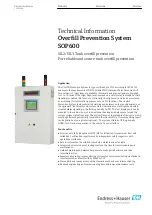
Overfill Prevention System SOP600
Hauser
3
Document information
Safety symbols
Symbol
Meaning
DANGER
DANGER!
This symbol alerts you to a dangerous situation. Failure to avoid this situation will result in
serious or fatal injury.
WARNING
WARNING!
This symbol alerts you to a dangerous situation. Failure to avoid this situation can result in
serious or fatal injury.
CAUTION
CAUTION!
This symbol alerts you to a dangerous situation. Failure to avoid this situation can result in
minor or medium injury.
NOTICE
NOTE!
This symbol contains information on procedures and other facts which do not result in
personal injury.
Function and system design
Function
The Hauser Liquiphant (point level switch) transmits the current level (point level exceeded
or not) to the Hauser Nivotester. If the High-High level is exceeded, the Nivotester opens
the fault-signaling contact which is connected to the safety PLC. The safety PLC detects a level alarm
and switches on the alarm siren and alarm strobe (field signaling MOPS) and/or opens the contact of
the tank-specific safety relay (AOPS). In addition, an alarm message appears on the touch panel and
text display unit, and the alarm is also signaled by the stack lights. If the High level is exceeded, this
only causes a warning message to appear on the touch panel and text display unit, and the stack
lights signal. A safety shutdown is not triggered, however. With the automated proof-testing
feature, the system offers users a simple, time-saving function that guides users through the proof
test on the touch panel. This proof test must be performed periodically (at least once per year) to
guarantee the functional integrity of the safety function. The actuator that is connected to the tank-
specific safety relays is not included in the scope of delivery. These are plant-specific and the
responsibility of the plant owner/operator.
There are two kinds of Overfill Prevention System:
•
MOPS:
The operator stops the supply of media to the tank by closing the corresponding valve or by
switching off the pump. This involves manual intervention in either case. The system alerts the
operator via the alarms on the display and via the signaling equipment installed in the field (siren
and strobe). In the event of a power failure, the integrated UPS ensures that the system remains
fully functional for up to 30 minutes.
•
AOPS:
The system prevents imminent tank overfill by automatically opening the fault-signaling
contacts, which in turn causes the connected actuator (valve/pump) to close/stop. No manual
intervention is required.


































